England offers adventures galore. Here are some highlights of a trip from the north to the south, with stops at many less-visited as well as some must-see sites.
We start at the top of the Isle of England, only thirty miles south of the border with Scotland, where what was once one of the richest lead mines in all of England, is now a museum of lead mining. (There is another Museum of Lead Mining just 75 miles north of here, but it is in Scotland - another adventure entirely.)
The entrance to the museum’s mine requires visitors to wear rubber boots, as water, pumped up from the lower levels, runs out of the mine at ground level. A tour down into this lead mine makes one grateful not to be lead mining for a living.
| |
Water flows from the mine entrance Killhope.
Interior photo courtesy Killhope Lead Mining Museum/Durham County Council. |
|
This is the Killhope Lead Mining Museum, and the site is as depressing as the name. The museum guides assure me that the name doesn't mean the "death of desire" but rather, that "hope" means "side valley" and that "kill" might be a reference to the fact that, before there were lead mines in the region, there were lime kilns in these valleys. Still "Killhope" brings to mind sad and disturbing images.
Most disturbing of all, however, is the ore sorting (or "washing") area where children as young as seven worked underground from sunup to sundown in the mid-nineteenth century.
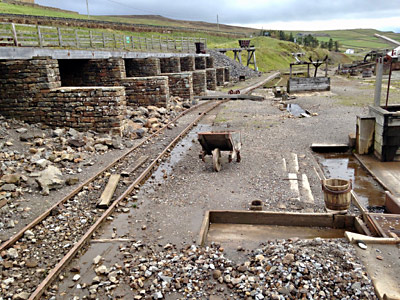
Children as young as seven sorted ore here in the 1850s and 1860s.
In the eighteen seventies, the washing was automated using the power from a new water wheel.

This water wheel provided power for separating lead from waste.
Photo courtesy Killhope Lead Mining Museum/Durham County Council.
Just over ten miles farther south, the River Tees spills over the High Force waterfall in County Durham. It is not the highest waterfall in England, but at more than 70 feet of concentrated flow it is certainly impressive. Locals have some logic behind their claim that it is England's "largest" waterfall, since the entire river plunges in a single cascade over a sharp precipice hemmed in by walls of igneous rock. When flowing full, following a good rain, this gives it the largest volume of water in a single fall, or, as the norsemen called it, a foss—which is the origin of the name "High Force."

High Force tumbles into a pool hemmed in by rock.
We hiked out a gentle, well maintained trail from the High Force Hotel which occupies what was once an eighteenth century hunting lodge. The foliage in fall was lovely and the rocky outcroppings glistened with the coating from a recent rain. The trail didn't offer a view of the Force itself until the very last curve, but when it came into view it was quite impressive.
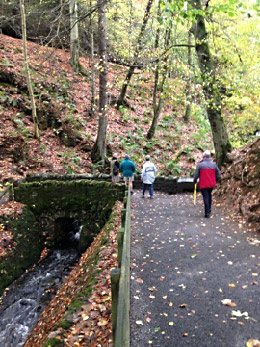
The walk to the falls is well maintained.
We were a bit chilled by the time of our return, so a stop in the hotel's cozy bar with its warm stove made the trip outstanding.
| |
The High Force Hotel and its cozy bar. Interior photo courtesy of The High Force Hotel. |
|
Twenty-five miles to the East, the ancient city of Durham bears witness to its history as the final resting place of Saint Cuthbert, the patron saint of Northern England. Its cathedral, which was built in 1093, and the adjacent castle, which is almost as old, are on the crest of the high hill overlooking the River Wear.
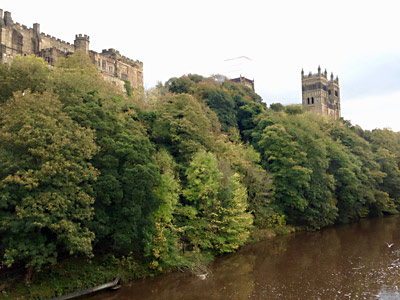
The tower of the Durham Cathedral is visible on the bluff above the Wear
Of note at the cathedral is a tiny detail you should not miss...the door knocker, which in the twelfth century, offered a chance for anyone who had committed a serious crime to seek refuge. Anyone knocking on the door was granted over a month of freedom to set his or her affairs in order. After 37 days, he or she would have to chose between standing trial or leaving the country.
| |
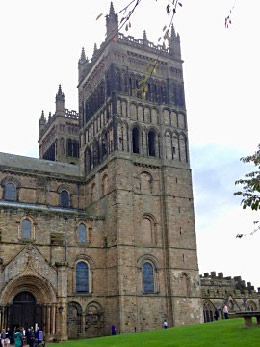 |
|
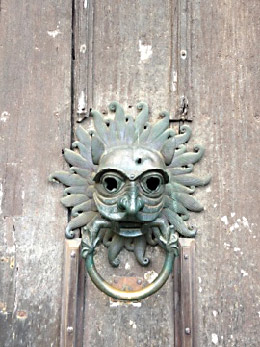 |
|
| |
Durham Cathedral tower
|
|
The knocker now on the door is but a replica—the original is in a museum. |
|
Try to time your visit for late afternoon so you can sit in the gorgeous interior as the cathedral's choir sings Evensong - the Anglican church's equivalent of the Roman Catholic Vespers which is sung everyday except Monday. Somehow the quiet of the interior of the cathedral is even more hushed and pervasive when the choir sings its softest at dusk, bringing a calm and peaceful end to a day of many highlights.
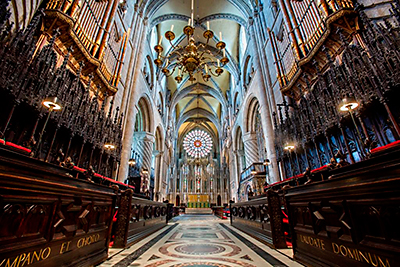
The oh-so-peaceful choir of the Durham Cathedral
Photo courtesy Chapter of Durham Cathedral.
Forty-five miles south of Durham's old but beautifully maintained cathedral is a gorgeous ruin of an abbey in a lovely setting adjacent to a water garden. The remains of the twelfth century Fountains Abbey are the largest monastic ruins in all of England. Fountains Abbey got its start in 1132 when a dozen monks wanted to establish a simpler life than they had in York. The abbey survived (if not thrived) for four centuries, but couldn't avoid Henry VIII's order confiscating monasteries, convents and other Catholic properties in 1539. The abbey and the grounds were sold to enrich the crown.
The largest monastic ruin in England: Fountains Abbey.
In 1768, Fountain's ruins were purchased by John Aislabie of Studley, a village in Warwickshire. He had created a classic water garden adjacent to the abby's grounds where the ruins provided a most dramatic background. The fact that their arches span empty windows and open spaces affords an incredible backdrop to the formal landscaping of the eighteenth century Studley Royal Water Garden. The ruins and the water garden are now a unified UNESCO World Heritage Site.
| |
Formal water gardens were all the rage in the eighteenth century. |
|
Travel 60 miles south to York, home of a cathedral built on the site of an old Roman fort…and multiple Christian installations built over the millennia. It was here that Constantine became emperor of Rome. He was here with the Roman army when his father died and the soldiers proclaimed him emperor. He went on to unify the entire Roman Empire, founded a new capitol named for himself, (Constantinople), and converted to the Christian religion, allowing free worship throughout his empire. Perhaps that is why his statue sits before the Minster.
The Minster and this statue of Roman Emperor Constantine mark the center of ancient York.
The York Minster ("minster" being an old word for a teaching church) has over half of all the remaining medieval stained glass in all of England. This is why most people visit the York Minster - to view the on-going restoration of its East Transept with a full wall of stained glass covering an area as large as a tennis court.
But there are other reasons to visit the Minster. For one thing, if you are up for a climb of 279 steps, you can wend your way up spiral stairs to the top of the central tower, where on a windy day, you can watch the lower towers sway! On the way up, you cross from the main structure to the tower itself over an outer walkway where you can get a good look at the flying buttresses that support the outer walls.
Climbing the Minster's tower offers closeup views of the structure and the flying buttresses.
After such a climb—assuming the weather provides a bit of a chill—you deserve a reward. Nothing better than a stroll of less than 100 yards down an eighteenth century street called Stonegate to number 46 for the lesser-known facility of the traditional English tea room chain of Betty's. There is a larger Betty's elsewhere in York, but this atmospheric small tea room is just the place for afternoon, well, tea. Enjoy it along with sandwiches (crustless, of course), scones or magical miniature cakes. You may have to spend a while on the stairs inside awaiting a table, for it seems that a great many people have discovered this respite from the hustle of the outside world. But once seated, you can settle into the ambiance of a genteel world you may have thought went away in a century past.
The warm interior of Betty's Tea Room shelters from the chilly outdoors - Photos courtesy of Betty’s.
Not everything worth seeing is north of London. So you might want to make it the jumping-off point for attractions south and west of the capitol city. Day trips will leave your evenings free to sample some of the cultural life in London.
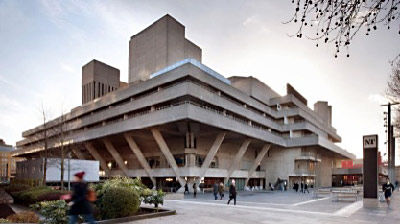
National Theatre's building on the South Bank of the Themes where Americans,
who have only seen "National Theatre Live" in their cinemas,
can see them live on stage.
Photo by Philip Vile compliments of National Theatre.
One night would be well spent at the National Theatre at the foot of the Waterloo Bridge on the South bank. There are three venues in its impressive, if brutalist, concrete bunker. The almost instantaneously transformable Dorfman Theatre can be a theater-in-the-round at one time and a more traditional four hundred and fifty seat stage-at-one-end-of-the-room theater at another. The Lyttelton has nearly forty percent of its eight hundred and ninety seats in its huge balcony. The star of the lineup, however, is the Olivier where 1,150 people can see productions on its massive stage that, due to its depth, height and massive backstage spaces, can add spectacle to drama. At a recent production of Saint George and the Dragon, the village in which the action takes place was seen both from the front and from above!
| |
 |
|
 |
|
Don't let the brutalist architecture of the outside dissuade you - there's a wealth of warmth inside in the Barbican Hall. Photos courtesy of Barbican Center, Silk Street Entrance by Max Colson, Barbican Hall by Mark Allan.)
On another night, head for the Barbican Centre less than half a mile north of the Themes on Silk Street. It is also a brutalist, poured concrete complex. However, with a concert hall, two theaters, three cinemas, an art gallery and an arts and music library, there will always be something there worth seeing or doing. If you are really lucky, you might find the London Symphony Orchestra in a hall with excellent acoustics delivering rousing performances of Rachmaninoff or Tchaikovsky.
The Great Western Railway takes you to Moseley where Henry VIII reigned in his Hampton Court Palace.
For a day trip, head west to Hampton Court Palace, only a dozen miles and ten stops on the South Western Railway in Moseley. Here's the palace where Henry VIII spent the most time. He travelled to many different castles, but this one was "home." A century after Henry VIII, the East side was spiffed up by William and Mary, but Henry's western entrance—the base court, the clock tower and court as well as Henry's apartments—remain relatively untouched (or restored) so you can get a real feel for the man and his reign.
Two impressive entrances stand between the River Thames and Henry VIII's Apartments
at Hampton Court Palace, the West entrance and the clock tower.
If you time your arrival right, you can have a fine lunch in the café in the tiltyard where Henry VIII and other Tudor monarchs held jousting tournaments. Don't get too enthralled at the idea that Henry might have jousted in this yard, however, as the tournaments here began after he'd already been injured in one elsewhere. He didn't very often mount his jousting steed again. The first tournament here was in 1557 when Queen Mary I held a Christmas joust. That became a tradition throughout the long reign of her sister, Queen Elizabeth I.
Further west is the oldest man-made attraction in England - Stonehenge. It isn't that easy to reach, as it isn't on an established rail route—but bus service from London is convenient and gives you time to watch the English urban scene turn suburban and then rural.

The modern visitors center for ancient Stonehenge was built in 2013
and includes an educational exhibit as well as a café and, of course, a gift shop.
The Stonehenge stone circle itself is located a fair walk of about a mile across open fields from the modern visitors center. That makes it remote enough to turn your mind from the modern amenities to the truly ancient phenomenon of the standing stones.
These aren't just rocks standing in a field, however. They are monumental and magnificent and leave you astonished that a prehistoric people could have quarried and transported the stones from as far away as the hills of Wales over a hundred miles to the West. Also, as Stonehenge is the only circle of standing stones in England where the stones have caps (or lintels) on top of them, how did they lift them up there? They are about fifteen feet above the ground.

The Stonehenge stone circle, in the middle of a field, is massive and impressive.
How old is Stonehenge? It probably was begun nearly five thousand years ago and took centuries to complete. That means it may be older than the great pyramids of Giza in Egypt!
Next, take a jaunt south to Surrey County. In the city of Guildford, you can visit a cathedral that doesn't date from hundreds of years ago, but was completed only decades ago. The work of Sir Edward Maufe, the cathedral’s exterior is not particularly noteworthy (it is twentieth century brick blah), but the interior as well as the carvings both inside and out are quite notable.
Guildford Cathedral is twentieth century brick blah on the outside but inside, has clean, soaring lines.
The carvings both inside and out are clearly modern.
One of the most impressive religious structures in England is not a cathedral at all and isn't really that old. It is a small chapel consecrated in 1898 in Compton, Surrey. It was built by Mary Watts, the wife of then-famous sculptor/portraitist/painter George Frederick Watts, whose gallery is nearby. Mary Watts was a terra cotta artist, and her brick work here is the opposite of Maufe's cathedral work: detailed and gorgeous.
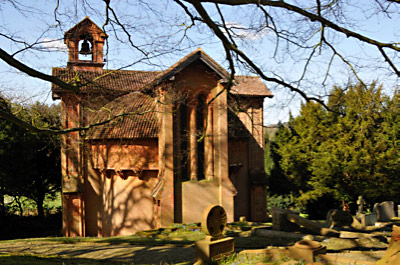
Small but impressive, the Watts Chapel stands in a cemetery
where Aldous Huxley, author of Brave New World, is buried.
Photo courtesy Watts Gallery - Artists' Village.
Since it’s a relatively small structure, it is possible to get up close to the detailed tiles on the exterior and then to proceed inside to see walls, nooks and arches painted in an art-nouveau style with definite Celtic influences.
The details are impressive both on the outside and the inside of the Watts Chapel.
Photos courtesy Watts Gallery - Artists' Village.
Surrey is a fine place to end the tour of England as Gatwick Airport lies at its border with Sussex. This airport is much easier to get into and out of than London's main international terminal at Heathrow. Even if you've established a base in London, it is still a good choice as the Gatwick Express from London's Victoria Station is a high-speed non-stop train that departs every 15 minutes and takes just 30 minutes. That's where we caught our Norwegian Dreamliner back across the pond.

photo courtesy Norwegian
|